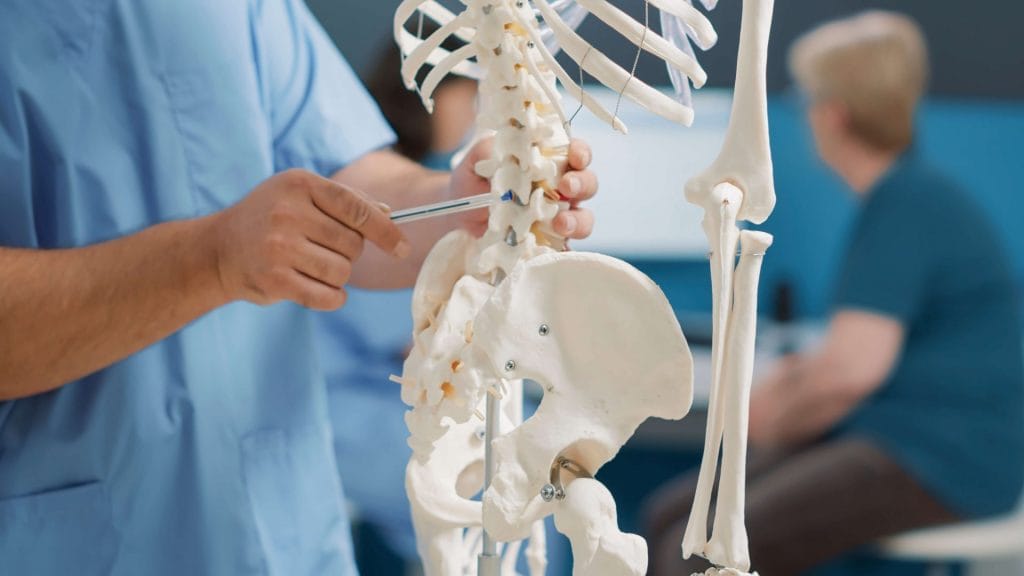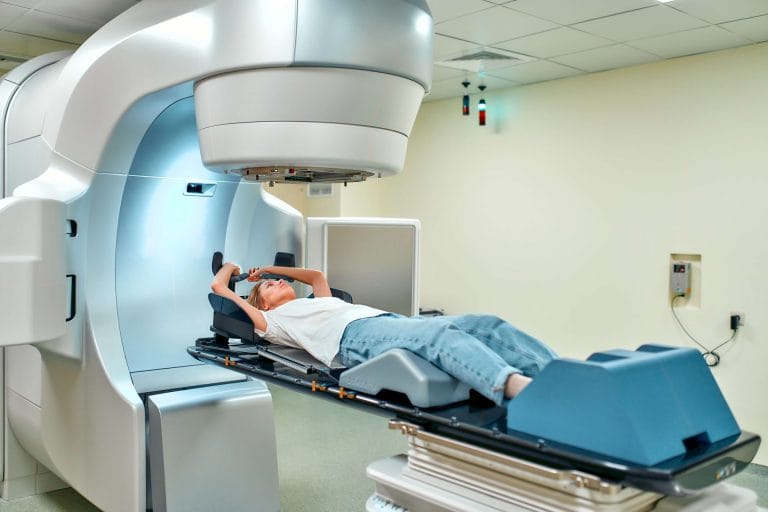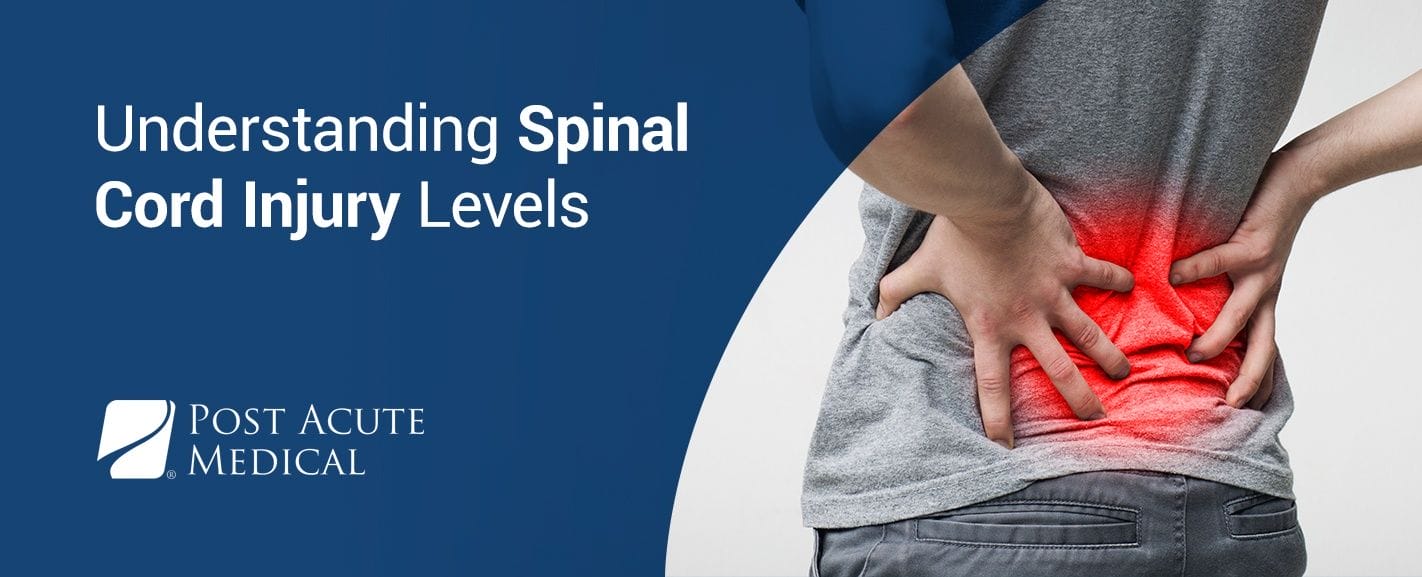
The spinal cord is an essential component of the body’s central nervous system. Injury to the spinal cord, either the vertebra or the nerves, can result from a fall, trauma or an underlying illness. The immediate and long-term effects of such an injury depend on the severity and location on the spinal cord. People who suffer spinal cord injuries can experience loss of sensation in a part of the body, impaired mobility and paralysis. What do the different spinal cord injury levels mean, and how do they affect your prognosis?
The Difference Between Complete and Incomplete Spinal Injuries
The classification of a spinal cord injury can be either complete or incomplete. What is the difference?
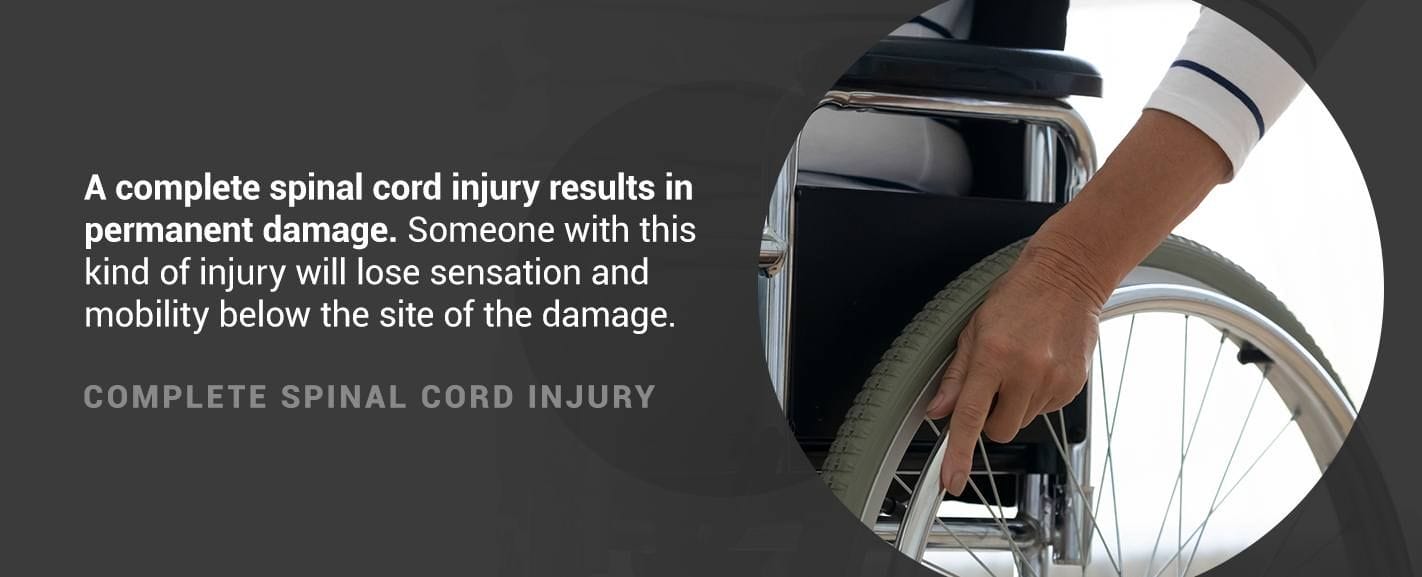
- Complete spinal cord injury: A complete spinal cord injury results in permanent damage. Someone with this kind of injury will lose sensation and mobility below the site of the damage. About half of all spinal cord injuries fall under this classification. This classification does not necessarily mean the patient has experienced a severed spinal cord. Instead, the injury can be a bruise or damage that results in compromised blood flow in the spinal column that affects the affected nerves’ ability to carry signals from the brain. These signals are what allow us to feel sensation in and control different parts of our body.
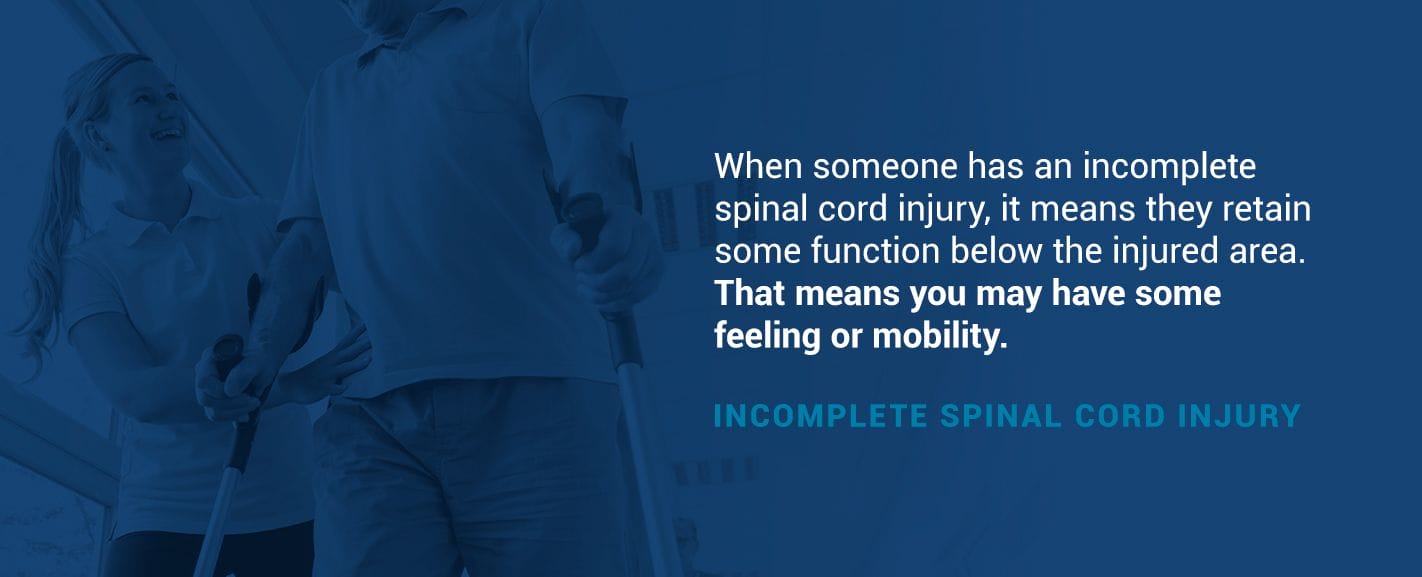
- Incomplete spinal cord injury: When someone has an incomplete spinal cord injury, it means they retain some function below the injured area. That means you may have some feeling or mobility. You may be able to move one limb more than another. Or, you may have sensitivity in an area of the body, but be unable to move it. The amount of movement and sensation available can vary widely for incomplete spinal cord injuries, depending on the injury’s location and severity. Someone with an incomplete injury may regain some feeling and mobility up to 18 months following the initial injury.
The American Spinal Injury Association (ASIA) impairment scale helps doctors assess sensory and mobility damage following various types of spinal cord injury. The scale, which covers both complete and incomplete injuries, ranges from the letter “A” to the letter “E.”
- A: Grade A spinal injuries are complete.
- B: Grade B spinal injuries are sensory-incomplete, which means the patient may have sensation in the affected area, but no motor function.
- C: Grade C spinal injuries are motor-incomplete, which means some motor function remains following the injury.
- D: Grade D spinal injuries are also motor-incomplete, but more than half the main muscles are at a 3 or above on ASIA’s muscle function scale, indicating active movement with a full range of motion against gravity.
- E: Grade E indicates normal function in terms of both sensation and motor skills.
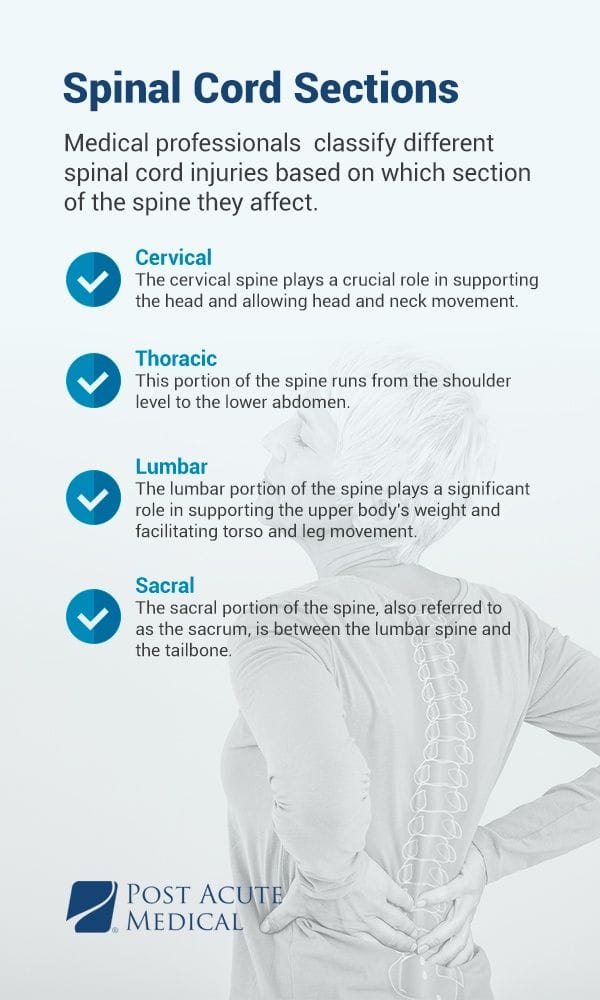
Spinal Cord Sections and Related Injury Levels
The spinal column, which houses the spinal cord, consists of 33 individual vertebrae. Doctors group the vertebrae into different sections, including cervical, thoracic, lumbar, sacral and coccyx, or tailbone. The bony spinal column protects the nerves of the spinal cord, which runs from the brain to the lower back.
Various parts of the spinal cord are responsible for different bodily functions, as follows.
- Motor functions: The ability to move voluntarily.
- Sensory functions: The ability to feel.
- Autonomic functions: Activities your body automatically manages, such as digestion and temperature.
A spinal injury impacts different bodily functions, depending on the affected area of the spine. In addition to the incomplete and complete groupings, medical professionals also classify different spinal cord injuries based on which section of the spine they affect.
- Cervical: The cervical spine is the first portion of the spine, beginning at the base of your skull and traveling down the neck to about shoulder level. It contains seven vertebrae, referred to as C1 through C7. Being so close to the head, the cervical spine plays a crucial role in supporting the head and allowing head and neck movement. The cervical vertebrae protect the cervical nerves within. The cervical portion of the spinal cord has multiple jobs. The cervical spinal cord includes eight pairs of spinal nerves, which are responsible for relaying messages from the brain to neck, shoulders, arms and hands.
Spinal cord injuries affect the site of the injury and below it. As such, cervical spinal nerve injuries tend to be the most severe type of spinal cord injury. Injury of the C1 to C6 nerves will likely result in quadriplegia, or paralysis that affects the arms and legs. In cases of cervical spinal cord injury, the person may be unable to move anything below the neck. Injuries on the lowest part of the cervical spinal cord, the C7 nerve, may allow someone to retain some control of their arms and hands.
Trauma is the most common cause of injury to the cervical spinal cord. Car accidents, falls or sports-related injuries can result in this kind of injury. Illness, such as cancer, may also affect the cervical spinal cord.
Severe paralysis that typically results from a cervical spinal cord injury has a series of effects. You will likely need assistance with day-to-day living. These types of injuries can result in permanent loss of bladder control, inability to breathe unassisted and impaired speech ability. Injuries that occur on the lowest part of the cervical spine may allow someone to retain more independence with specialized equipment. Recovery from this type of injury is unlikely. Most people who experience damage to the nerves of the cervical spine won’t be able to live alone, and will need help for the rest of their lives.
- Thoracic: The thoracic spine is the next segment. It is also the longest, including 12 vertebrae: T1 to T12. This portion of the spine runs from the shoulder level to the lower abdomen. There are a total of 12 nerve roots on each side of this part of the spinal column. The nerves in the thoracic spine control many different bodily functions. The first two nerves, T1 and T2, branch out and connect to nerves in the chest, arms and hands. The nerves in the middle, T3 to T8, extend and connect with nerves in the chest and abdomen. The remaining nerves, T9 to T12, extend into the abdomen and lower back. The thoracic portion of the spinal cord is essential in helping you balance and controlling the muscles that allow you to breathe.
Thoracic spinal nerves play a role in our limbs’ sensation and movement, as well as our ability to breathe. Any injury to this area of the spine can hamper feeling and movement. Typically, injuries to the thoracic spine result in paraplegia, rather than quadriplegia. Paraplegia is paralysis of the lower half of the body, which means loss of movement and sensation from the waist and below. Paraplegia results in an inability to walk and loss of bladder and bowel control.
As is the case with cervical spine injuries, trauma is also the most likely cause of injury to the thoracic spinal cord. A car accident, a severe fall or a gunshot wound could injure the thoracic spinal nerves.
At a lower level of the spine than the cervical nerves, thoracic nerve injury may allow for a greater level of independence following recovery. You may have full use of your upper body and have mobility with the help of a manual wheelchair. Some people who have had a thoracic nerve injury, depending on its location, may be able to stand with the help of a frame or braces. There are also modified cars available for those who do not have use of their lower limbs.
- Lumbar: The lumbar spine has five vertebrae, L1 through L5, which are the largest in the back. The lumbar portion of the spine plays a significant role in supporting the upper body’s weight and facilitating torso and leg movement. This section of the spinal cord has five pairs of nerves, also referred to as L1 through L5. The nerves run through the lower back and connect with nerves in the legs. The L1 nerve is associated with sensation in the genitals and control of the hips. The second, third and fourth lumbar spinal nerves help control the movement of the legs, including the hips, thighs and knees. The last lumbar nerve, L5, helps control and provide sensation to parts of the legs, feet and toes.
In most cases, lumbar spinal cord injuries are not life-threatening. Injury to this area of the spinal cord may result in hampered mobility and sensation in the legs and hips. Loss of bowel and bladder control is also common with this type of spinal cord injury. Incomplete lumbar injuries will likely result in less loss of mobility and sensation, while complete lumbar injuries can result in paraplegia.
Lumbar spinal injuries are most commonly the result of trauma caused by car accidents, falls and violence. Congenital defects and degeneration due to age can also cause injury to this area of the spine.
Following a lumbar spinal cord injury, patients will undergo a recovery process. The prognosis for this type of injury depends on its location and severity. In most cases, people can retain a high degree of independence. People with complete injuries resulting in paraplegia can learn how to use a wheelchair. Others with less severe injuries may be able to move with the help of braces.
- Sacral: The sacral portion of the spine, also referred to as the sacrum, is between the lumbar spine and the tailbone. While the spinal cord ends in the lumbar spine at the L2 vertebra, there are still nerves below this point in the spine. Damage to these nerves can still adversely affect mobility and sensation. The S1 through S5 vertebrae of the sacral spine are fused in a triangle shape. These bones protect the S1 through S5 sacral nerves. This group of nerves is the sacral plexus. Together, these nerves serve several sensory and motor functions for the lower portion of the body. The S1 nerve supplies the hips and groin areas of the body. The S2 nerve allows for functioning in the back of the thighs, while S3 supplies the medial buttock. The last two sacral nerves, S4 and S5, affect the perineal region, or the area between the anus and the genitals.
Doctors don’t classify sacral nerve damage as injury to the spinal cord. Therefore, the prognosis for this type of injury is typically more favorable than for damage that occurs higher on the spine. Sacral nerve damage may affect one side of the body, or be bilateral. While there will usually be some effect on motor function and sensation in the hips or legs, most people can still walk following this kind of injury.
Injury to this portion of the spine and its nerves can result from any of the same issues that can affect other areas of the spine. Sacral spine injuries are the potential outcome of car accidents and other trauma, as well as congenital defects and age-related degeneration.
You will likely be able to live your life with a high degree of independence following a sacral nerve injury. Because the sacral nerves supply sensation to the lower regions of the body, sexual dysfunction and loss of bladder and bowel control are common following a sacral nerve injury. Sacral nerve damage in men may lead to infertility. Patients’ condition can improve over time and with treatment, such as anti-inflammatory drugs, physical therapy and potentially surgery.
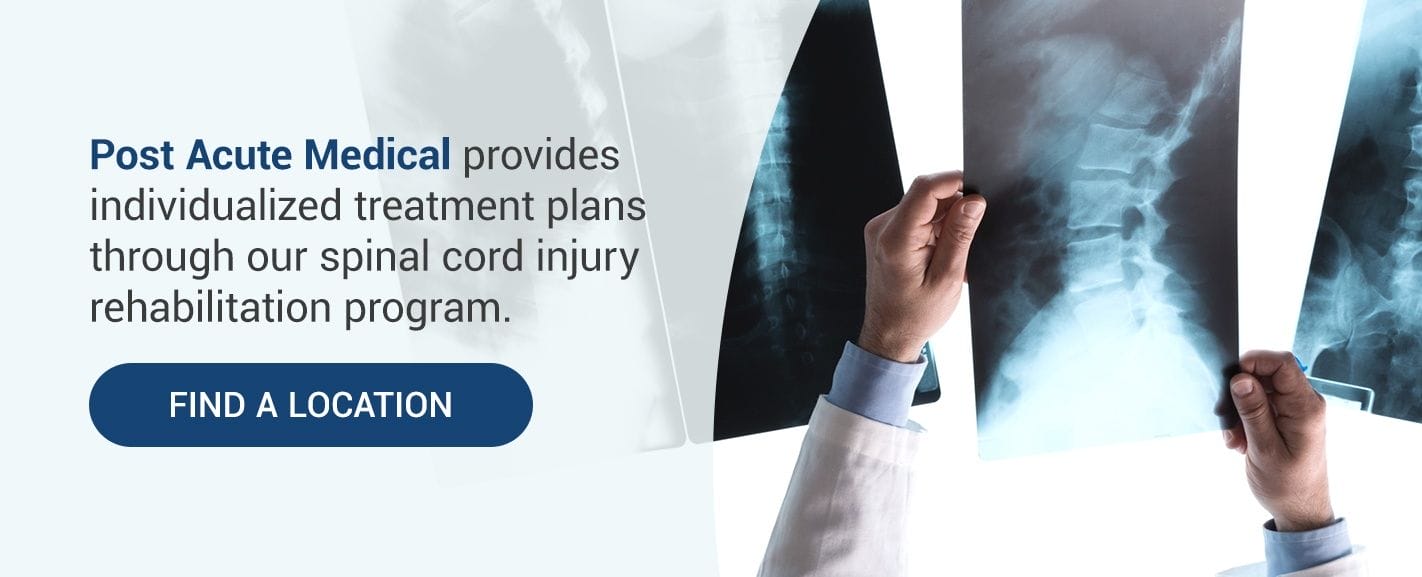
Recovering From a Spinal Cord Injury
Whether it has happened to you or someone you love, life after a spinal cord injury can be scary and difficult to imagine. How will you cope with changes to your mobility and ability to feel? If you are a caregiver, how can you provide the right kind of support for your loved one? You are not alone. There are multiple resources available to help you recover from an injury and move forward. Post Acute Medical provides individualized treatment plans through our spinal cord injury rehabilitation program. Browse our website to learn about the resources we offer for our patients and their families. We want to help you get the care you need and develop the necessary skills to maintain as much independence as possible.
